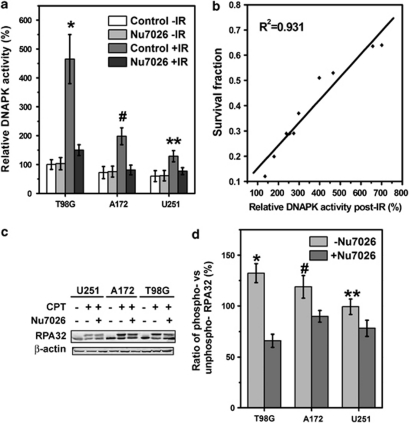Figure 3.
Ionizing radiation (IR)-induced DNA-dependent protein kinase (DNA-PK) activity is correlated with radiation resistance in glioblastoma cells. (a) T98G, A172 and U251 cells were treated with Nu7026 (10 μM) 30 min before irradiation (5 Gy) or without radiation. At 1 h post-irradiation, the nuclear fractions from these cells were isolated, and then subjected to a DNA-PK kinase assay using a specific peptide as substrate (*P<0.001; #,**P<0.05). (b) The dose–response relationship between DNA-PK activity and the survival fraction of glioblastoma cells was analyzed by the Mann–Whitney U-test. The coefficient of determination (R2) in the linear regression model is indicated. (c) T98G, A172 and U251 cells were treated with Nu7026 (10 μM) for 30 min before camptothecin (CPT) treatment. At 3 h post-irradiation, whole-cell lysates were subjected to immunoblotting for total or phospho-specific RPA32 detection using RPA32 antibody (top row). β-Actin was used as a loading control. (d) Phosphorylated and unphosphorylated RPA32 were quantified by the Image J software, and the readings were normalized to the internal control of β-tubulin. The error bars represent the S.D. of the means of three independent experiments. The statistical significance of the differences between the ratio of phosphorylated to unphosphorylated RPA32 in each cell line was determined by Student's t-test (*P<0.001; #,**P<0.05)

